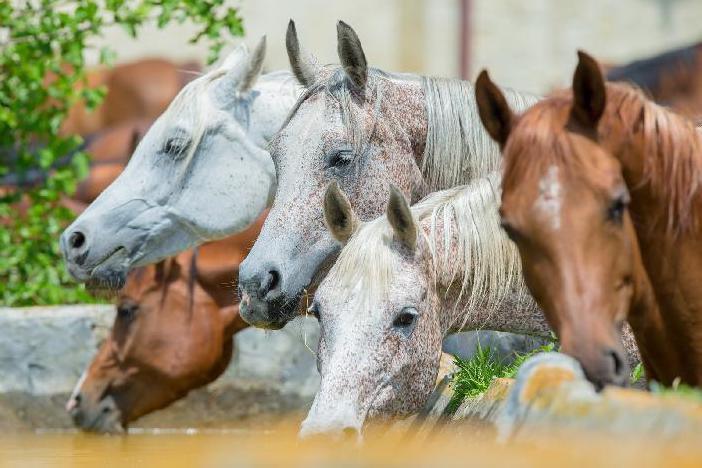
12 minute read
access to resources as needed
b e h a v i o r Understanding Emotional Resilience
Kathie Gregory outlines the importance of emotional resilience in both humans and animals, why it is so essential to have the ability to cope with the stressors we face in everyday life
Advertisement
During the months of isolation and social distancing many of us standing, problem solving, the ability to adjust, paying attention, comhave been exposed to during the pandemic, the need for emo prehension and decision making. Emotional aspects include selfawaretional resilience has become stronger than ever. Emotional re ness, selfesteem, selfregulation, selfconfidence and selfcare. silience can help people cope better with whatever life throws at them, Knowledge leads to awareness, which leads to understanding. When such as dramatic changes in situations and circumstances. It can also re an animal understands a situation he is able to adjust, problem solve, and duce stress and help people recover more quickly from adverse experi make decisions. When he also has the emotional quality of selfawareences and return to equilibrium. ness, his decisions will be based on what is good for him rather than detriEmotional resilience is necessary for homeostasis and maintaining a mental. When he has selfesteem, he gains selfconfidence, which also healthy mind and body, and it plays a big part in rehabilitation tech has an effect on his ability to interpret and act on intellectual data. Selfniques to overcome trauma. In my experience, however, the concept is regulation comes from a combination of all these things. In this balanced not always readily applied to animals. But while what constitutes emo psychological state, an animal can maintain equilibrium and is able to distional resilience varies in different animals, it is every bit as necessary engage, so is not prone to obsessive actions. No less importantly, he is for all species, in my opinion. able to determine the best course of action for his own wellbeing. There are three main three main influences on emotional resilience to consider: Social physical, psychological, and social. Some The social element is about connections, relafactors are common to all species, while tionships, communication, cohesion, belonging some are species specific. and feeling safe in your group. Every social
Physical
The physical element covers health, nutrition, and exercise. Health is not just about being free of illness, but also about being physically capable and strong enough to complete physical tasks with enough energy, enthusiasm, and/or motivation. Nutrition has to be adequate to provide overall health, but also to support the strength and energy needed to carry out daily tasks. Adequate exercise is necessary to support an animal's ability to perform well and not fatigue prematurely.
Psychological
The psychological influences include intellectual and emotional aspects of the mind. Intellectual factors include knowledge, awareness, underspecies needs to connect with others of the same species and isolation can be enorEmotional resilience includes knowing when to react and when to ignore things, when to disengage, when to mously damaging. In the 1950s, in a series of controversial experiments, Harlow separated focus, when to relax, when to engage baby monkeys from their mothers and kept in social activities, and when to seek quiet time them in partial or full isolation. The end result was that the infants displayed severely disturbed behavior, resulting, sadly, in the deaths of some of the monkeys. Making connections allows animals to get to know each other and develop friendships, which are essential for a healthy psyche. Social settings enable communication between animals and working together creates cohesion in the group. A sense of safety and belonging is the result of being in a sta© Can Stock Photo / gurinaleksandr
ble social environment.
SelfCare
Beyond physical, psychological and social support, every being needs the ability to administer selfcare. For that to happen, the individual needs to be aware of what is good for him and what is not. This means having the ability to know one's own limits, when to react and when to ignore things, when to try harder, when to stop, when to remove oneself from negative situations, when to disengage, when to focus, when to relax, when to feel content, when to engage in social activities, and when to seek quiet time. All of these factors contribute to emotional resilience.
To live a contented life with a strong body and mind, animals rely on emotional resilience. So when we ask our pets to participate in different activities, which may or may not be acceptable for them in terms of
what is appropriate for their breed or species, we should acknowledge that just because an animal participates in an activity, he may not necessarily enjoy it. An alternative approach is to address the three elements of emotional resilience and include them in every aspect of keeping animals, tailoring our strategy for each individual animal.
Establishing an emotional resilience program should be part of an overall management strategy for every animal, and we should apply the same strategy to ourselves. Often, we neglect our own selfcare as life is too busy, but it is essential to find ways to incorporate it into our lives too.
A resilience program enhances an already adequate life and gives an animal a better chance of being able to cope with difficult, scary, or unpleasant events and situations that are bound to occur during his lifetime. It is not a means of compensation for neglect, a poor life, and inappropriate elements, however. As we have already established, emotional resilience requires a certain level of physical, psychological, and social health to manifest resilient traits in the first place. The aim is to then improve the health of body and mind to help the animal reach his emotional potential.
Surviving vs. Thriving
Resilience means different things to different people. Some would describe it as the ability to cope, survive, and get through life. Rather than surviving, some describe it as thriving – adaptability, strength, and robustness. Kaplan et al. (1996) describe it as the capacity to maintain competent functioning in the face of major life “stressors,” while Cutter et al. (2008) describe it as “the ability of a social system to respond and recover from disasters and includes those inherent conditions that allow the system to absorb impacts and cope with an event, as well as postevent, adaptive processes that facilitate the ability of the social system to reorganize, change and learn in response to a threat.” Wilson (2010), meanwhile, states that resilience is “about the ability of a system to absorb impacts⁄disturbance and to reorganise into a fully functioning system, as well as postevent adaptive processes.”
Resilience is necessary for the ongoing small stressors that we face in everyday life as well as the ability to weather a significant event. It is a mechanism to protect a being from the negative effects of adverse situations, anticipated difficulties, unexpected events, and stressful situations, whether short or longterm, mild or extreme. It also constitutes the ability to overcome hardships and remain positive, which enables the mind to shield itself. This protective quality also has a positive effect on the body and helps guard against a variety of physical issues.
Developing Resilient Traits
There are actually two very distinct aspects to emotional resilience: resilient traits and dynamic response. We may ask, why do some people maintain a healthy mind and not succumb to stress related disorders
The social element is about connections, relationships, communication, cohesion, belonging and feeling safe in your group. Every social species needs to connect with others of the same species and isolation can be enormously damaging.
and dysfunctional behavior despite experiencing adversity, when others have a very different response to stress? Resilience research is still in its infancy, but studying why some individuals are resilient and others are not can lead us towards a greater understanding of the mindbody connection, and how to shield against stress related disorders, rather than dealing with them only once they have manifested.
Research supports that one aspect of developing resilient traits is genetic. However, in reality, this may have little influence. What has more influence is a person’s or animal’s environment, including what the mind is exposed to, how it responds, and how it is guided to learn during early development.
We understand how early experiences can shape a mind and create strength or weakness, but we sometimes forget that this starts in utero. The life the mother has when pregnant is the first influence on how the infant mind develops. However, this does not mean does not mean we are unable to develop resilient traits later in life. We are all capable of becoming more resilient in our mindset.
Resilience traits also develop with age. A youngster with little life experience will have limited resilience traits, whereas an older animal who has gained knowledge and understanding and has experienced a variety of situations, has the ability to develop coping strategies that contribute to his overall resilience.
Not surprisingly, flexible thinking is also a very important emotional resilience trait. It allows us to react and adjust to new situations, helping us find ways to navigate through them. This flexibility then leads to new knowledge and experiences, which help the brain update its current perception, which in turn further supports flexible thinking and progression of perspective. This new perspective can help us understand and respond constructively to adversity in the future.
Having said that, traits alone are not what makes a being successfully resilient. Resilience is actually a dynamic process that activates at the time of stress. People or animals may have the potential for emotional resilience, but until something adverse or stressful happens, they do not know what their response will be or how they will cope during the situation – or indeed how they will recover afterwards.
Most researchers agree that resilience is not the product of unawareness, an inability to react, or passivity in the face of adversity.
ATTENTION WRITERS! Get Published in BARKS from the Guild or on the BARKS Blog!

Got something to share? We are always on the lookout for interesting features, member profiles, case studies and training tips to feature in BARKS from the Guild and on the BARKS Blog. If you’d like to join the growing band of member contributors, please get in touch!
BARKS from the Guild BARKS blog Email: barkseditor @petprofessionalguild.com
To live a contented life with a strong body and mind, animals rely on emotional resilience. So when we ask our pets to participate in different activities, which may or may not be acceptable for them in terms of what is appropriate for their breed or species, we should acknowledge that just because an animal participates in an activity, he may not necessarily enjoy it.
Rather, the resilient brain responds to stressful experiences with an active adaptation process that encompasses different aspects of the mind. The adaptations may be temporary or permanent, depending on the situation and the individual. Recent studies have revealed that the neural systems of animals undergo adaptations and change when exposed to adversity (Kalisch et al., 2017).
So while resilient traits are a good safeguard for minor stressors, situations and event, they may have less effect when we are faced with major occurrences. When we experience the latter, our emotional resilience is really determined by the activation of the dynamic process. How the brain actually responds to adversity, how it copes in the aftermath of an adverse experience and recovery from the experience determine the active emotional resilience a being has. This process can subsequently make changes in the brain that ensure it is better prepared next time.
Resilience is complex and engages several parts of the brain. Being aware of these traits and dynamic responses can enable us to try to form more adaptive coping strategies, something we can think about in our daytoday interactions with both people and animals, something we can apply in our daytoday interactions with both people and animals. n
References
Cutter, S., Barnes, L., Berry, M., & Burton, C. (2008). A place-based model for understanding community resilience to natural disasters. Global Environmental Change 18(4) 598-606 Kalisch, R., Baker, D.G., Basten, U., et al. (2017). The resilience framework as a strategy to combat stress-related disorders. Nature Human Behavior 1 784–790 Wilson, G. (2010). Multifunctional Quality and Rural Community Resilience. Transactions of the Institute of British Geographers 35(3) 364381
Resources
Chowdhury, M.R. (2020). What is Emotional Resilience and How to Build It? (+Training Exercises) Kaplan, C.P., Turner, S., Norman, E., & Stillson, K. (1996). Promoting Resilience Strategies: A Modified Consultation Model. Children & Schools 18(3) 158–168 Psychology Notes HQ. (2020). Harlow’s Monkey Experiment – The Bond between Babies and Mothers Wright, C., Kiparoglou, V., Williams, M., & Hilton, J. (2012). A Framework for Resilience Thinking. Procedia Computer Science 8 45-52
Kathie Gregory is a qualified animal behavior consultant, presenter and author, specializing in advanced cognition and emotional intelligence. Passionate about raising standards and awareness in how we teach and work with animals, she has developed Free Will TeachingTM , a concept that provides the framework for animals to enjoy life without compromising their own free will. She has authored two books, A tale of two horses: a passion for free will teaching, and A Puppy Called Wolfie: a passion for free will teaching, and her work is currently divided between working with clients, mentoring, and writing.

The A-Z of Training and Behavior Brought to you by
M is for... Maintenance: The phase of training in which stimulus control has been attained. Cue response occurs both accurately and with minimal latency. The proofing part of the training process has been completed. Ex. The pet sits on cue even when the trainer lies on the floor or calls the cue from another room.
Management: Preventing the pet from being exposed to the antecedent stimulus. An important tool in behavior modification as it prevents the rehearsal of the undesired behavior. Ex. Pet’s trainer moves the pet behind a car to prevent the pet from seeing the stranger. The pet therefore does not rehearse barking and lunging.
Matching Law: Matching law suggests that when different schedules of reinforcement are available at the same time for different behaviors the pet will behave according to the relative rates of reinforcement available for each behavior performed. Therefore, the pet will engage, exhibit more of the behavior that produces the highest levels of reinforcement.

Medical Model: The medical model perspective on behavior is that behaviors can be categorized, labeled and treated with standardized protocols. Unlike the ethological, psychological and medical mode orientation the behavioral perspective on behavior is that behavior is a function of its environment and that environmental stimuli cause behavior as opposed to genetics.
Modal Action Pattern: Formerly referred to as Fixed Action Pattern. MAP’s are instinctive or innate behaviors. An innate pattern of coordinated behaviors that have a somewhat fixed form and need not to be learned.
From: A Lexicon of Practical Terms for Pet Trainers & Behavior Consultants: The language you need to know! by DogNostics Career Center. Available from: dognosticseducation.com/p/store










